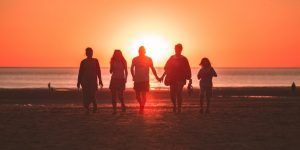What Is Circular Questioning in Family Therapy? 20 Examples
 Our mindset often becomes fixed regarding our family relationships, environment, and the obstacles in our way.
Our mindset often becomes fixed regarding our family relationships, environment, and the obstacles in our way.
Circular questioning can bring clarity and offers a valuable shift in our perspective (Rogers & Cooper, 2020).
Placing ourselves in the shoes of other family members by imagining what they think and feel can help develop an understanding of why they behave as they do.
This article explores how circular questioning can introduce new ideas and information to our clients’ thinking. We also walk through some techniques and questions that we can use to implement this powerful tool in our family therapy sessions.
Before you continue, we thought you might like to download our three Positive Psychology Exercises for free. These science-based exercises will explore fundamental aspects of positive psychology including strengths, values, and self-compassion, and will give you the tools to enhance the wellbeing of your clients, students, or employees.
This Article Contains:
What Is Circular Questioning?
Circular questioning is a technique used in systemic family therapy to “invite participants in a conversation to consider relational aspects of the topic being investigated” (Evans & Whitcombe, 2015, p. 28).
Therapists use circular questioning with individuals, couples, and families to help them see alternative or new options and possibilities, and explore other people’s views.
To make it easier to understand what circular questions are and acquire the skills needed to use them, Fleuridas, Nelson, and Rosenthal (1986) developed a taxonomy to distinguish them from linear questions.
A circular question should have one or more of the following attributes. They should (modified from Evans & Whitcombe, 2015):
- Help define the problem the family faces
- Elicit responses that suggest how situations have changed over time (temporal questions)
- Invite consideration regarding how the interactions of two family members might affect a third (triadic questions)
- Include hypotheticals that invite the family to change their behavior (interventive questions)
Unlike linear questions, which are ideal for eliciting definitive facts and content and determining information about the situation, circular questioning encourages reflection and exploration regarding how the issue relates to others within the family.
Evans and Whitcombe (2015, p. 29) offer the following helpful example:
Linear question: How long has your mother had problems with her memory?
Circular question: Who is most affected in the family by your mother’s memory problems?
Three of the most popular circular question techniques used in therapy include (Fleuridas et al., 1986; Evans & Whitcombe, 2015):
Temporal questions
Temporal questioning encourages reflection on what has happened in the past and the changes that have taken place over time (Evans & Whitcombe, 2015).
They elicit detail regarding an event and “exploration of optimism or pessimism, and consideration of a time in the future when things might be different or improved” (Evans & Whitcombe, 2015, p. 30).
For example, Was anything different in how you were treated before, compared with now?
Triadic questions
Triadic questioning invites reflection regarding how two people’s actions impact the behavior or mood of another. Such questions are often used to assess how families respond to their members in different situations (Evans & Whitcombe, 2015).
Such as asking a child, How does your father react when your mother cries?
Mind reading questions
Mind reading questioning invites individuals to consider what someone else might think in order to explore how their relationship works. The respondent reflects on their knowledge of the person to evaluate what they might do or say (Evans & Whitcombe, 2015).
For example, If your father didn’t arrive home as expected, how do you think your mother would react?
Crucially, circular questioning prompts the respondent to consider alternatives and think beyond the available facts. They can search for meaning behind events they have witnessed.
Family and Systemic Therapy Explained

Systemic family therapy, in particular, focuses on “understanding relationships between individuals and their situations” (Evans & Whitcombe, 2015, p. 28). Special attention is paid to essential factors in a relationship, including:
- Context
- Inherent rules and boundaries
- Communication
Ultimately, the aim of this approach is to understand the presenting problem and identify alternative ways of coping (Evans & Whitcombe, 2015).
Systemic thinking focuses on how people within a group relate to one another (known as dynamic complexity), rather than the specific detail of the individual group members (detail complexity), and derives from systems theory (Evans & Whitcombe, 2015).
Systems theory is a powerful approach that encourages considering humans as part of a system and members of subsystems, and understanding how component parts impact and interact with one another. Such systems have inputs, outputs, processes, and outcomes, and provide feedback. When change happens, the system adapts, and a new balance (or homeostasis) is achieved (Rogers & Cooper, 2020).
Selvini, Boscolo, Cecchin, and Prata (1980) introduced the notion of circularity, as part of what became known as the Milan-style of systemic family therapy, to better understand the circular nature of connections between people, their environment, and outcomes. They rejected the central positivist stance that proposed the understanding of cause and effect using a linear approach (Brown, 1997; Evans & Whitcombe, 2015).
The circular technique also lends itself to engaging curiosity – something that therapists should aspire to – when working with a family to explore alternative views, explanations, and narratives. Such curiosity, and the belief that knowledge of the relationships in a family is crucial, supports the use of circular questioning in family therapy (Evans & Whitcombe, 2015).
From a practical standpoint, social workers often implement systemic practice with families using small teams rather than individual social workers.
The benefits include (Rogers & Cooper, 2020):
- Enabling team members to provide input while focusing on their various strengths
- Providing a forum where social workers can discuss cases while multiple hypotheses are developed and tested
- Reducing the burden of administrative tasks on individual social workers
“The benefits of systemic thinking in this collaborative format include allowing the broadest range of possibilities to emerge while uncovering wisdom held within a group.”
Rogers & Cooper, 2020, p. 254
Circular Questioning in Therapy: 20 Examples
Clients arriving for family therapy often feel overwhelmed by their problems. Their focus may have narrowed due to their impact, and they may no longer see the environment in which it exists (Brown, 1997).
Moving away from a linear explanation of the problem to seeing the pattern that connects it to a broader context can result in a more complete picture.
Brown (1997) provides some practical examples of circular questioning for use in therapy categorized by content.
Behavior
A focus on behavior can help in understanding what has led to the situation or problem. Such questions can often be more neutral and may appear less judgmental, paying attention to how someone acts rather than their values.
Examples (modified from Brown, 1997):
- When she stays out late without telling you where she is, what feelings come up for you?
- How does shouting at your son relate to your beliefs about child rearing?
- How do you make sense of the difference between his behavior at home and school?
- When the family argues, does it bring you all closer together or further apart?
Feelings
Questioning feelings can be helpful for “understanding the meaning and motivations of behavior” while increasing client self-understanding (Brown, 1997, p. 113).
Examples (modified from Brown, 1997):
- How do you feel when she calls you incompetent?
- When he tells you that he doesn’t love you anymore, what emotions emerge?
- When you spend long periods feeling angry with each other, how do you think that affects your relationship?
- When she feels sad, what feelings do you have?
Beliefs
Beliefs often arise from difficult or uncomfortable past experiences or our environment. Asking questions to understand another’s thoughts and ideas can help uncover why they act, feel, and think as they do (Brown, 1997).
Examples (modified from Brown, 1997):
- When he is reluctant to help with the housework, what do you think he believes about the role of women?
- When she is sad about not having had a child, do you think it is more because she wants a child or because her family wants a grandchild?
- When you believe that conflict should be out in the open in any relationship, does he agree more or less with you?
- When you believe that there is a danger in expressing your anger at home, do you think that unites or separates the family?
Meaning
“Meaning questions tap into the way that clients interpret their world through their interaction with others” (Brown, 1997, p. 113). Their answers can cast light on behavior in an interpersonal context and, combined with feelings and beliefs, can be a powerful force for change.
Examples (modified from Brown, 1997):
- When he is feeling sad, what do you think his sadness is about?
- When she thinks that your anger relates to unresolved issues with your mother rather than her, how do you think she gets that idea?
- When you say that his behavior shows he doesn’t want to live at home anymore, how do you think he sees that statement?
- When she says that she feels you do not love her anymore, how do you think that affects your relationship?
Relationships
Families are, by their very nature, built on relationships. Allowing family members to comment on their relationships with one another can uncover false assumptions and provide the impetus for change.
Examples (modified from Brown, 1997):
- When she says that she is coming home right after school is finished and does not do so, how do you think that affects the nature of your relationship?
- When he is angry and expresses that to you, does that make you feel closer together or further apart?
- When you believe that relationships should not have any conflict, what does that say about your relationship when conflict continues?
- When she is pessimistic about your willingness to be more involved in the family, how do you think that affects your relationship?
4 Techniques and Questions to Ask

The therapist aims to create difference in a session by turning unhelpful statements into “useful information that uncovers subtle differences ignored by the family,” creating an alternative to an existing, dominant view (Brown, 1997, p. 111).
Differences can be created or identified between past, present, and future as well as between relationships, people, perceptions, and events. Brown (1997) offers a set of example questions categorized under time, people, parts of a person, and situations, as follows:
Across time (temporal)
Changes take place across time and often go unnoticed. By contrasting past, present, and future, the therapist can create or identify differences (Brown, 1997).
For example, looking into the future, we may think that problems will no longer exist.
Examples modified from Brown (1997) include:
- When did the problem begin?
- When is the problem most difficult?
- When is the problem least evident?
- How long will it take for this problem to go away?
- How might the problem change in the future?
Between people
Identifying differences between people can help highlight behavior, attitudes, and beliefs that are being ignored. This can be especially true when the family fails to notice that one member is having a more extreme reaction to an event, such as a death (Brown, 1997).
Examples of such questions, modified from Brown (1997), include:
- Who is the most argumentative in the family? Who next?
- Who most believes that parents should make all the rules in the family? Who next?
- Who is most committed to the relationship? How do they show it?
- Who most shows their concern about the problem?
Between parts of a person
Behavior is multidimensional. We cannot categorize a person for behaving in a particular way, as they may be ambivalent, having strong contradictory attitudes regarding how to act (Brown, 1997).
Examples of questions that explore this ambivalence include (modified from Brown, 1997):
- Thinking of your head and heart, which part wants to stay in the relationship, and which part wants to leave?
- How much are you angry versus sad about your grandmother’s death?
- Do you think his feelings or his thoughts rule him more when he stays out late? What do you think those thoughts are?
- When you feel angry with her, what part of you taps into your current feelings about the situation versus your feelings from the past?
Between situations
“Differences between situations highlight differences in client behavior, attitudes and beliefs, depending on the context” (Brown, 1997, p. 112). It can be insightful to highlight differences in behavior between contexts.
Examples modified from Brown (1997) include:
- Is he more likely to be violent in public or private? Why do you think that is the case?
- In what situation is the problem most noticeable?
- When are your religious beliefs most obvious to others?
- Where do you think you are most yourself: at work or at home?
Circular questioning in systemic family therapy
Helpful Resources From PositivePsychology.com
We have many helpful worksheets for therapists or counselors working with clients individually or as part of family therapy. Try out the following with your clients to identify strengths within the family, bring clarity to relationships, and recognize values that are important to all.
- Seeing Family Conflict as a Problem to Solve
This worksheet helps family members recognize everyday actions as problems to be overcome rather than points of contention using a set of commonly shared rules. - Mind the Gap
This exercise helps family members explore the gap between the values they wish to enact and their behaviors, creating an opportunity to live more in line with a value-driven moral code. - Meeting Our Family’s Needs
This exercise presents a series of questions to help family members recognize the met and unmet needs that lead to happiness or conflict within a household. - Recognizing Family Narratives
This worksheet helps families recognize the family narratives, flowing from roles, rituals, and more, that explain the structure of interactive patterns within the family. - Codependent Relationships: Beliefs, Attributes, and Outcomes
This checklist presents a definition of codependency and examples of beliefs, actions, and outcomes reflective of healthy versus codependent relationships. - 17 Positive Psychology Exercises
If you’re looking for more science-based ways to help others enhance their wellbeing, this signature collection contains 17 validated positive psychology tools for practitioners. Use them to help others flourish and thrive.
A Take-Home Message
Relationships within a family can, at times, be fraught. Our thoughts, beliefs, and past can prevent us from seeing things as they are, hindering us from overcoming problems and moving forward.
Circular questioning can help by changing our perspective and encouraging us to imagine how others think and feel. We can explore relationships within the family and introduce new ideas and ways of thinking to see things differently. The answers bring greater awareness to a situation and provide perspective on how others see us and our family roles.
“Circular questioning lends itself to respondents considering alternatives, thinking beyond the ‘facts’ they have experienced” and can offer further explanation and meaning behind actions they have witnessed (Evans & Whitcombe, 2015, p. 31).
Not only that, but the approach promotes interest and curiosity in the therapist and strengthens their commitment to bring transparency and enlightenment to a problematic family situation.
The questions included can be modified as needed to be relevant to various circumstances encountered in family therapy. Review them and consider how you might use them to further your understanding of the problems and bring clarity to your clients’ lives and relationships.
We hope you enjoyed reading this article. Don’t forget to download our three Positive Psychology Exercises for free.
- Brown, J. (1997). Circular questioning: An introductory guide. Australian and New Zealand Journal of Family Therapy, 18(2), 109–114.
- Evans, N. & Whitcombe, S. (2015). Using circular questions as a tool in qualitative research. Nurse Researcher, 23(3), 28–31.
- Fleuridas, C., Nelson, T. S., & Rosenthal, D. M. (1986). The evolution of circular questions: Training family therapists. Journal of Marital and Family Therapy, 12(2), 113–127.
- Rogers, M., & Cooper, J. (2020). Systems theory and an ecological approach. In M. Rogers, D. Whitaker, D. Edmondson, & D. Peach, Developing skills & knowledge for social work practice (pp. 259–268). SAGE.
- Selvini, M. P., Boscolo, L., Cecchin, G., & Prata, G. (1980). Hypothesizing – circularity – neutrality: Three guidelines for the conductor of the session. Family Process, 19(1), 3–12.
- Ward, S. (2013). Social work practice and relationship breakdown. In M. Davies (Ed.), The Blackwell companion to social work (pp. 151–158). Wiley Blackwell.
Let us know your thoughts
Read other articles by their category
- Body & Brain (50)
- Coaching & Application (57)
- Compassion (26)
- Counseling (51)
- Emotional Intelligence (24)
- Gratitude (18)
- Grief & Bereavement (21)
- Happiness & SWB (40)
- Meaning & Values (26)
- Meditation (20)
- Mindfulness (45)
- Motivation & Goals (45)
- Optimism & Mindset (34)
- Positive CBT (29)
- Positive Communication (20)
- Positive Education (47)
- Positive Emotions (33)
- Positive Leadership (18)
- Positive Parenting (4)
- Positive Psychology (33)
- Positive Workplace (37)
- Productivity (17)
- Relationships (46)
- Resilience & Coping (38)
- Self Awareness (21)
- Self Esteem (38)
- Strengths & Virtues (32)
- Stress & Burnout Prevention (34)
- Theory & Books (46)
- Therapy Exercises (37)
- Types of Therapy (64)






What our readers think
Great summary. Useful work sheets. Accessible language therefore making theory applicable to everyday practice. Thankyou.
Thanks! Helped me clarify my thoughts for an article I am going to post. Enjoy the days ahead,